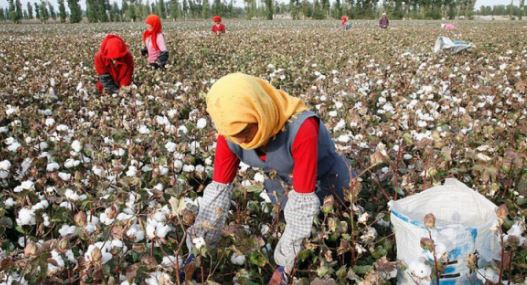DNA
Islamabad, Aug 12: Xinjiang cotton has comparative advantage and befitting lessons for Pakistan, says a report published by Gwadar Pro on Friday.
Furthermore, adopting Chinese techniques of intercropping and double cropping is the way forward for Pakistani cotton farmers.
Quoting Dr. Mehmood Ul Hassan Khan, Director of the Center for South Asia & International Studies (CSAIS), the report stated, mechanical harvesting in Xinjiang saved 50 percent consumption of water and 30 percent of fertilizer. It also reduced the labour cost by 30 percent while enhanced the yield by the same percentage. Thus close Pak-China mechanical harvesting cooperation will further strengthen cotton yields in the country.
Development of new types of cotton seeds, and getting assistance from the Chinese molecular biology to introduce such new seeds that adapt to climate in the country should be encouraged.
Luckily, the Punjab government has provided two agro-based industrial zones in Vehari and Bhalwal that offer several incentives to Chinese firms including tax waivers which should be used for forming a corridor of knowledge between two countries.
Cotton is one of the largest crops in Pakistan but its unit yield is far behind that in Xinjiang. Pakistan and Xinjiang are adjacent to each other and have similar natural conditions; it is easier for many Xinjiang companies to breed high-yield and high-quality cotton seeds suitable for planting in Pakistan.
Natural gold fiber cotton may have push-over economic stimulation under CPEC in the country. Moreover, joint efforts and close cooperation in cotton production would further accelerate the prospects of joint ventures in garments projects in the days to come.
Thus Xinjiang and Pakistan cotton production cooperation is the way forward which should be executed as soon as possible.
With constant “structural reforms” especially in the economy, agriculture, agro-machinery, investments, and infrastructure development, Xinjiang region has become a “hub” of global cotton production. Now it has specific “comparative advantage” in the world cotton production.
Xinjiang is the largest cotton growing region in China, ranking first nationally in total output, per unit production and planting area for the last two decades. In 2020, the total cotton planting area in Xinjiang reached 2.51 million hectares, nearly the same as in 2019.
Xinjiang is expected to see another bumper harvest this year which is good omen for the national economy and exports of the country.
Moreover, the China Cotton Association (CCA) statistical data upholds that more than half of farmers in Xingjiang usually grow cotton, with the majority being ethnic minorities. Cotton farming is the major source of local agricultural income in south Xinjiang.
It is true that cotton fields bring handsome income to growers, but also provides substantial employment opportunities to many migrant workers. In this regard, nearly 4,000 people in the Aral township in Aksu Prefecture joined the migrant cotton-picking community year, earning an average of nearly RMB 6,000 (about $895) per capita in two months, with the champion cotton picker pocketing RMB 23,000. Over 90 percent of north Xinjiang cotton fields are now harvested using machinery. The practice is also becoming popular in south Xinjiang.
Xinjiang’s cotton output accounts for about a fifth of the world total, while China’s textile and apparel exports make up about one third of the global value. Moreover, to propel the industry’s growth, Xinjiang has shared its cotton growing expertise with other areas such as some central Asian countries. The cotton growers of Pakistan should learn valuable lessons from it.
China has certain comparative advantage in cotton research and industrialization with advanced biological breeding technology for cotton, high-quality cotton seed production technology and high-yield and high-efficiency cultivation and management technique for cotton, which should be shared with the Pakistani cotton growers under CPEC in the country.
It would be new value-addition for the streamlining, systemizing and further strengthening of cotton cooperation between Pakistan and China.
China has standardized production technology of cotton seed which has enabled the rate of seed germination to reach above 85 percent. In Xinjiang, the temperature is relatively lower, but the plastic film covering technology helps raise the temperature of soil, thus promoting the germination and growth of seeds.
Furthermore, the Chinese innovative and technologically advanced smart agriculture can make the cultivation and management of cotton more feasible, realize the prevention and control of plant diseases and insect pests, and predict the yield in advance in the country which should be incorporated in the domestic productive channels of Pakistan.
Because of climate change, there is an urgent need to create new cotton germ plasma that is resistant to both biological and abiotic stresses, develop high-quality and long-fiber cotton, establish and improve mechanized planting and harvesting, and optimize management measures for planting and cultivation. Thus Pak-China (Xinjiang) cotton cooperation is the need of hour.
In this connection, CPEC has already established China-Pakistan Cotton Biotechnology Joint Laboratory, which aimed at introducing high technology into Pakistan, as well as a comprehensive platform for agricultural technical cooperation.
Rigorous and joint seed research for right atmosphere, cotton-peanut intercropping and plant architecture that allows for mechanical harvest enabled Xinjiang to enhance its share in China’s cotton production from less than 4 percent in 1949 to 76 percent as of today, the report added.
















